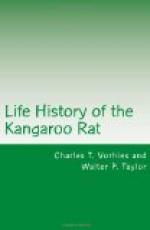[Illustration: PLATE VIII. FIG. 1.—CONTENT OF DEN EXCAVATED IN NEW MEXICO.
Storage content of Den No. 24, of Table 1, from Sandia Mountains, N. Mex. This is the largest lot of storage taken in the course of the investigations. The larger pile consists wholly of a valuable grass, Sporobolus cryptandrus strictus: the smaller of Russian thistle (Salsola pestifer.)]
[Illustration: PLATE VIII. FIG. 2.—GROWTH FOLLOWING ELIMINATION OF KANGAROO RATS.
The same mound as shown in Plate III, Figure 1, after three years of protection, the rodents having been killed out. Nearly as good grass recovery following poisoning operations occurred in the single excellent season of 1921.]
At times, more especially in the seasons of active growth, some of the green and succulent portions of plants are eaten. This was very noticeable in the spring of 1919, when a most luxuriant growth of Mexican poppy (Eschscholtzia mexicana) occurred. Stomachs at this time were filled with the yellow and green mixture undoubtedly produced by the grinding up of the buds and flowers of this plant. Small caches of about a tablespoonful of these buds were also found in the burrows at this time. Occasionally in spring one may find a few green leaves of various plants, Gaertneria very commonly, tucked away in small pockets along the underground tunnels, indicating that such materials are used to some extent. As has been shown in detail, however (Table 1), the chief storage, and undoubtedly the chief food, consists of air-dry seeds.
The character of the storage, the absence of rain for months at a time in some years, and the consequent failure of green succulents show that without doubt spectabilis possesses remarkable power, as to its water requirements, of existing largely if not wholly upon the water derived from air-dry starchy foods, i.e., metabolic water serves it in lieu of drink (Nelson, 1918, 400), this being formed in considerable quantities by oxidation of carbohydrates and fats (Babcock, 1912, 159, 170). During the long dry periods characteristic of southern Arizona, no evidence that the animal seeks a supply of succulent food, as cactus, is found; and if it may go for two, three, or six months without water or succulent food, it is reasonable to suppose that it may do so indefinitely. In the laboratory spectabilis ordinarily does not drink, but rather shows a dislike for getting its nose wet. During the periods of drought the attacks upon the cactuses by other rodents of the same region, as Lepus, Sylvilagus, Neotoma, and Ammospermophilus, become increasingly evident. The list of plant species thus far found represented in the storage materials of spectabilis on the Range Reserve is shown in Table 3.
TABLE 3.—List of all plant species found in 22 dens of Dipodomys spectabilis_ on the United States Range Reserve, near the Santa Rita Mountains, Ariz., with approximate total weights._




